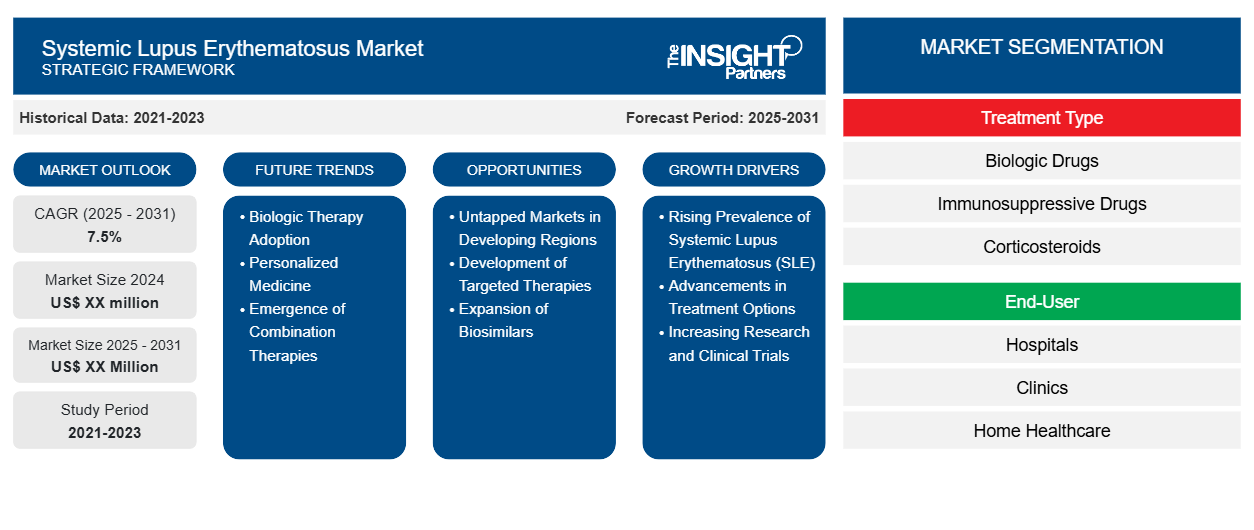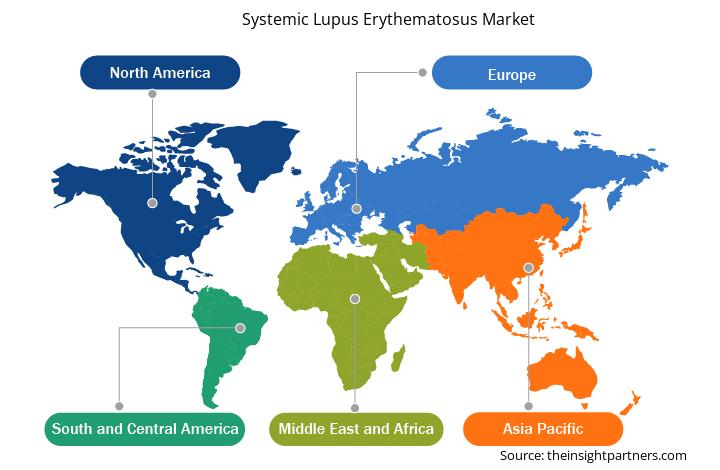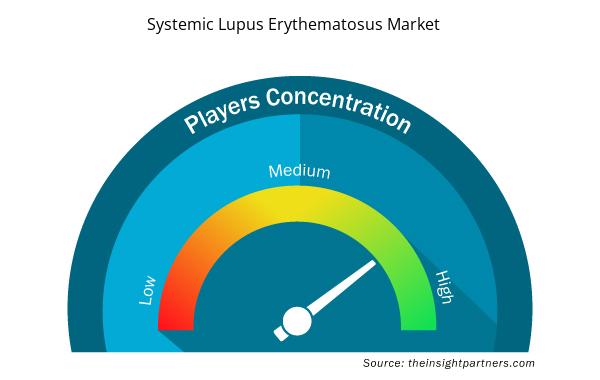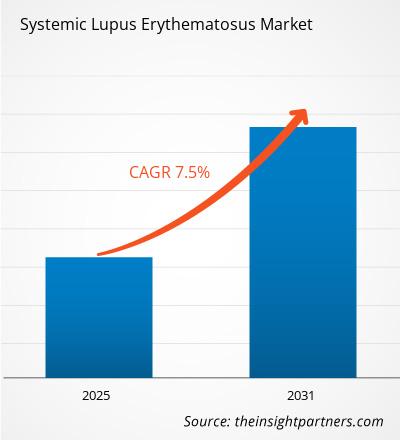The Systemic Lupus Erythematosus Market is expected to register a CAGR of 7.5% from 2025 to 2031, with a market size expanding from US$ XX million in 2024 to US$ XX Million by 2031.
The report is segmented by Treatment Type (Biologic Drugs, Immunosuppressive Drugs, Corticosteroids, Non-steroidal Anti-inflammatory Drugs, Others). The market is further segmented based on by End-User (Hospitals, Clinics, Home Healthcare, Research Institutes). The global analysis is further broken-down at regional level and major countries. The Report Offers the Value in USD for the above analysis and segments.
Purpose of the Report
The report Systemic Lupus Erythematosus Market by The Insight Partners aims to describe the present landscape and future growth, top driving factors, challenges, and opportunities. This will provide insights to various business stakeholders, such as:
- Technology Providers/Manufacturers: To understand the evolving market dynamics and know the potential growth opportunities, enabling them to make informed strategic decisions.
- Investors: To conduct a comprehensive trend analysis regarding the market growth rate, market financial projections, and opportunities that exist across the value chain.
- Regulatory bodies: To regulate policies and police activities in the market with the aim of minimizing abuse, preserving investor trust and confidence, and upholding the integrity and stability of the market.
Systemic Lupus Erythematosus Market Segmentation
Treatment Type
- Biologic Drugs
- Immunosuppressive Drugs
- Corticosteroids
- Non-steroidal Anti-inflammatory Drugs
End-User
- Hospitals
- Clinics
- Home Healthcare
- Research Institutes
Customize This Report To Suit Your Requirement
You will get customization on any report - free of charge - including parts of this report, or country-level analysis, Excel Data pack, as well as avail great offers and discounts for start-ups & universities
Systemic Lupus Erythematosus Market: Strategic Insights

- Get Top Key Market Trends of this report.This FREE sample will include data analysis, ranging from market trends to estimates and forecasts.
Systemic Lupus Erythematosus Market Growth Drivers
- Rising Prevalence of Systemic Lupus Erythematosus (SLE): The increasing incidence of systemic lupus erythematosus, particularly among women of childbearing age, is a major driver for the SLE market. With rising awareness and better diagnostics, more individuals are being diagnosed, leading to greater demand for treatment options and drugs for managing symptoms and complications associated with the disease.
- Advancements in Treatment Options: Recent advancements in drug development, including biologics and immunosuppressants, have significantly improved treatment outcomes for SLE patients. These treatments, which target the underlying immune system dysfunction, provide better efficacy and safety profiles, driving the market's growth and adoption in clinical practices globally.
- Increasing Research and Clinical Trials: The growing number of research studies and clinical trials aimed at understanding and treating SLE has contributed to the market's expansion. Pharmaceutical companies are investing heavily in R&D to develop innovative therapies, which fuels the market by introducing new, more effective drugs for SLE treatment.
Systemic Lupus Erythematosus Market Future Trends
- Biologic Therapy Adoption: The increasing adoption of biologic drugs in treating SLE is a key market trend. Biologics like belimumab have shown promising results in managing disease activity and preventing flares, becoming an essential part of treatment regimens. This trend is set to continue with further drug approvals and advancements in biologic treatments.
- Personalized Medicine: Personalized medicine, using genetic and biomarker data to tailor treatments to individual patients, is gaining traction in the SLE market. This trend allows for more effective treatments and minimizes adverse side effects, thus improving patient outcomes and creating a more targeted approach to managing SLE.
- Emergence of Combination Therapies: Another trend is the growing use of combination therapies, where multiple treatment modalities are used together to manage symptoms and disease progression more effectively. These therapies aim to reduce flare-ups and improve long-term disease management, becoming increasingly popular in the SLE treatment paradigm.
Systemic Lupus Erythematosus Market Opportunities
- Untapped Markets in Developing Regions: There is a significant opportunity for growth in emerging markets such as Asia-Pacific, Latin America, and Africa. As awareness of SLE improves, these regions are poised to see a rise in diagnosis and treatment, creating demand for effective SLE management solutions and opening up new market prospects for pharmaceutical companies.
- Development of Targeted Therapies: The opportunity for creating more targeted therapies for SLE is vast. Researchers are focusing on therapies that can specifically target the immune system dysfunction in SLE, thus offering patients more effective and safer treatment options. The development of such therapies can meet the unmet needs in managing the disease.
- Expansion of Biosimilars: The increasing availability of biosimilars for existing biologics presents a major opportunity in the SLE market. These more affordable alternatives to branded biologics will help make treatment accessible to a larger patient population, particularly in low-income and developing regions, thereby expanding the market.
Systemic Lupus Erythematosus Market Regional Insights
The regional trends and factors influencing the Systemic Lupus Erythematosus Market throughout the forecast period have been thoroughly explained by the analysts at Insight Partners. This section also discusses Systemic Lupus Erythematosus Market segments and geography across North America, Europe, Asia Pacific, Middle East and Africa, and South and Central America.

- Get the Regional Specific Data for Systemic Lupus Erythematosus Market
Systemic Lupus Erythematosus Market Report Scope
| Report Attribute | Details |
|---|---|
| Market size in 2024 | US$ XX million |
| Market Size by 2031 | US$ XX Million |
| Global CAGR (2025 - 2031) | 7.5% |
| Historical Data | 2021-2023 |
| Forecast period | 2025-2031 |
| Segments Covered |
By Treatment Type
|
| Regions and Countries Covered | North America
|
| Market leaders and key company profiles |
Systemic Lupus Erythematosus Market Players Density: Understanding Its Impact on Business Dynamics
The Systemic Lupus Erythematosus Market market is growing rapidly, driven by increasing end-user demand due to factors such as evolving consumer preferences, technological advancements, and greater awareness of the product's benefits. As demand rises, businesses are expanding their offerings, innovating to meet consumer needs, and capitalizing on emerging trends, which further fuels market growth.
Market players density refers to the distribution of firms or companies operating within a particular market or industry. It indicates how many competitors (market players) are present in a given market space relative to its size or total market value.
Major Companies operating in the Systemic Lupus Erythematosus Market are:
- GlaxoSmithKline plc
- AbbVie Inc.
- Johnson & Johnson
- Bristol-Myers Squibb Company
- Roche Holding AG
- Eli Lilly and Company
Disclaimer: The companies listed above are not ranked in any particular order.

- Get the Systemic Lupus Erythematosus Market top key players overview
Key Selling Points
- Comprehensive Coverage: The report comprehensively covers the analysis of products, services, types, and end users of the Systemic Lupus Erythematosus Market, providing a holistic landscape.
- Expert Analysis: The report is compiled based on the in-depth understanding of industry experts and analysts.
- Up-to-date Information: The report assures business relevance due to its coverage of recent information and data trends.
- Customization Options: This report can be customized to cater to specific client requirements and suit the business strategies aptly.
The research report on the Systemic Lupus Erythematosus Market can, therefore, help spearhead the trail of decoding and understanding the industry scenario and growth prospects. Although there can be a few valid concerns, the overall benefits of this report tend to outweigh the disadvantages.
- Historical Analysis (2 Years), Base Year, Forecast (7 Years) with CAGR
- PEST and SWOT Analysis
- Market Size Value / Volume - Global, Regional, Country
- Industry and Competitive Landscape
- Excel Dataset



Report Coverage
Revenue forecast, Company Analysis, Industry landscape, Growth factors, and Trends

Segment Covered
This text is related
to segments covered.

Regional Scope
North America, Europe, Asia Pacific, Middle East & Africa, South & Central America

Country Scope
This text is related
to country scope.
Frequently Asked Questions
The key drivers include the rising prevalence of SLE, advancements in biologic and immunosuppressive treatments, and an increasing number of clinical trials and research dedicated to understanding and treating the disease.
Trends include the increasing use of biologic drugs, the shift towards personalized medicine, and the growing adoption of combination therapies for more effective disease management.
Opportunities include expanding into emerging markets, the development of targeted therapies for SLE, and the growing availability of biosimilars, which offer more affordable alternatives to current biologics.
Common treatments include biologic drugs, immunosuppressants, corticosteroids, and NSAIDs. Biologics, such as belimumab, have become particularly important in managing disease activity and preventing flares.
North America and Europe are expected to dominate the SLE market, owing to advanced healthcare infrastructures, while Asia-Pacific and Latin America present growing opportunities due to improving healthcare access.
Challenges include the high cost of biologic therapies, the complexity of early diagnosis, and the need for personalized treatments tailored to individual patients to address the unique nature of SLE.
Trends and growth analysis reports related to Life Sciences : READ MORE..
- GlaxoSmithKline plc
- AbbVie Inc.
- Johnson & Johnson
- Bristol-Myers Squibb Company
- Roche Holding AG
- Eli Lilly and Company
- Novartis International AG
- Sanofi S.A.
- Pfizer Inc.
- MedImmune, LLC (AstraZeneca)

 Get Free Sample For
Get Free Sample For